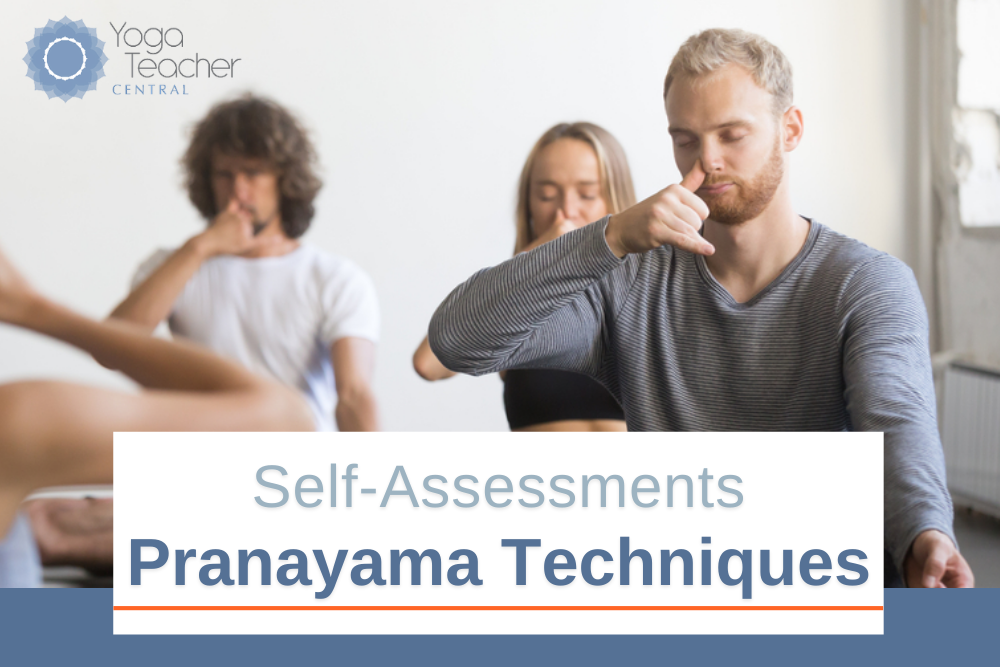
Introduction
Quickly assess your knowledge of Pranayama Techniques, and identify gaps in your education. See below for assessments on these subjects:
- Ujjayi
- Nadi Shodhana
- Kapalabhati & Bhastrika
Purpose
Offer a series of free quizzes for yoga teachers to:
- Provide an effective way to assess knowledge of each of the Teaching Knowledge Standards.
- Make it easy to self-assess privately, on your own time.
- Help teachers who identify educational gaps to bolster their knowledge with accessible and practical lessons.
More Self-Assessments
For more self-assessments, see the Standards & Self-Assessment Hub.
Ujjayi

Teaching Standard
Become familiar with teaching considerations and instructions for Ujjayi Pranayama, also known as known as Victorious Breath.
Assessment
- Describe Ujjayi pranayama.
- What is the common focal point of concentration in Ujjayi?
- How can Ujjayi help with mindfulness practice?
- For what purpose or benefits might one practice Ujjayi?
- What is the meaning of the Sanskrit word, “ujjayi?”
- Give instructions for practice.
Nadi Shodhana

Teaching Standard
Become familiar with teaching considerations and instructions for Nadi Shodhana, also known as Anuloma Viloma and Alternate Nostril Breathing.
Assessment
- What is the primary purpose or effect of this practice?
- What other benefits are reported from this practice?
- What does “Nadi Shodhana” mean?
- How does brain dominance impact us?
- Why is inter-hemispheric transference important and what is the result of increased activity across the corpus callosum?
- What are the contraindications for Nadi Shodhana?
- Give instructions for hand placement.
- Describe instructions for practice.
- Describe a simpler variation to consider with beginners or for when there is little time.
Kapalabhati & Bhastrika

Teaching Standard
Become familiar with teaching considerations and instructions for Kapalabhati, known as Skull Shining Breath, and review an introduction to Bhastrika, Bellows Breath.
Assessment
- While often referred to as a type of pranayama, what is a more technically accurate description of Kapalabhati?
- The translation of kapalabhati is “skull shining.” While some refer to it as the “Breath of Fire,” why may this be somewhat confusing?
- What might be considered the fundamental purpose of the practice?
- What other benefits /effects are reported from the practice of Kapalabhati?
- Describe four suggestions for mindfully preparing to practice Kapalabhati.
- Provide teaching instructions.
- What variation might experienced practitioners wish to try?
- Experienced practitioners may wish to move to a single nostril version.
- Describe Bhastrika.
- When are these breath practices contraindicated?
Next Steps

- To view more self-assessments, go to the Standards & Self-Assessment Hub.
- To bolster your knowledge and be recognized as a YTC teacher, enroll in the Yoga Teacher Central Study Program (details below).
- Members, view clear and concise lessons:

In a Nutshell
- The enrollment fee is $25 and is open to Yoga Teacher Central members, past members and non-members.
- Members receive current membership benefits plus additional benefits listed below.
- Enrollment in the Study Program qualifies you for lifetime YTC Teacher status.
Benefits
Enrolling in the Study Program gives you:
- A downloadable Knowledge Standards Lesson Guide to walk you through a structured study path toward certification.
- Selection of 5 downloadable lessons of your choice (from a library of nearly 500).
- Recognition as a YTC Teacher (for life; no expiration).
- Professional marketing kit for highlighting your YTC Teacher status on social media and your website.
- Excellent preparation for taking certification exams.
Members
- Your current membership gives you online access to not only thousands of pages of organized study and teaching knowledge, but also sequence breakdowns and teaching notes, theme plans, injury cheat-sheets, and so on.
- When you enroll in the Study Program, you get these additional benefits: a Knowledge Standards Lesson Guide, selection of 5 downloadable lessons of your choice, and a professional marketing kit for highlighting your YTC Teacher status on social media and your website.

See here for information about exams, badges and certification. Get links for each exam, and for a no-risk trial exam.
We think you’ll enjoy taking the exams. The questions are well-thought-out and the subject matter is quite engaging and significant for teachers. You’ll get an inspiring teaching after answering each question. At the end of the exam, you see a summary of wrong answers and the relevant teachings, giving you a personal study guide targeted to your needs.
This is an hour well-spent!







